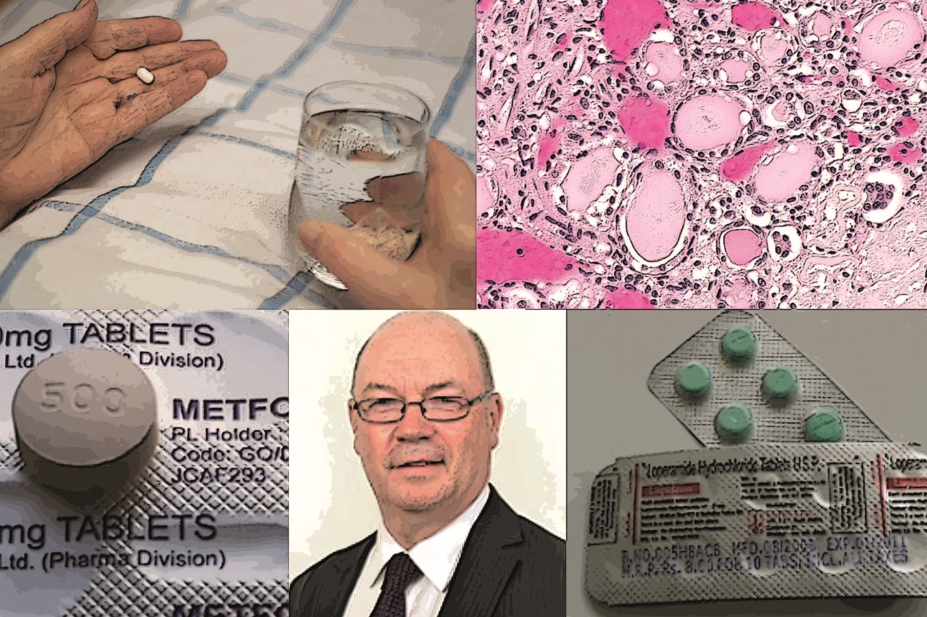
The Pharmaceutical Journal
Warnings about the cardiovascular risks of using supratherapeutic doses of the antidiarrheal loperamide and a prediction that up to 3,000 community pharmacies could close as a result of funding cuts feature in our most popular news stories of the year.
January 2016
2016 started badly for the community pharmacy sector in England, which was reeling from the announcement made by the Department of Health on 17 December 2015 that funding for 2016–2017 would be cut by 6%.
A warning that as many as one in four pharmacies could close as a result of the funding cuts formed the basis of our fifth most read story of the year, a rare policy story among a mainly clinical top ten.
The All-Party Pharmacy Group (APPG) had issued a statement following a meeting with the then pharmacy minister Alistair Burt saying that the minister had predicted that between 1,000 and 3,000 pharmacies could close in England after the planned funding cuts. Burt told the APPG that the government would not decide which pharmacies should close, but admitted that independents would be ‘squeezed’.
After the meeting, held on 17 January 2016, the APPG’s chair Sir Kevin Barron said: “There is a clear intention to reduce the number of pharmacies.”
The APPG’s interpretation of Burt’s comments was widely reported in the pharmacy press, forcing the minister to deny that there were any government plans for closures.
February 2016
Clinical topics dominated our ten most popular news stories of 2016, with medicines safety a recurring theme. In February, we published our fourth most popular story of the year about the potential risk of dementia associated with use of proton pump inhibitors (PPIs), a widely used class of drugs used to treat gastric reflux and stomach ulcers.
A study published in JAMA Neurology[1]
had highlighted a link between PPI use and dementia, leading researchers to suggest that avoidance of PPI medication may prevent development of the condition. The researchers discovered that patients who used PPIs regularly — at least one prescription per quarter in an 18-month period – had a 44% higher risk of developing dementia than patients not prescribed PPIs.
The researchers pointed out that their findings were in line with animal studies in which the use of PPIs increased the levels of β-amyloid in the brains of mice.
April 2016
Safety concerns relating to the use of PPIs surfaced again in April 2016, which brought two of our most popular stories of the year.
There is a well established link between the use of PPIs and acute kidney damage, particularly the development of interstitial nephritis, and evidence has linked the drugs with chronic kidney disease (CKD). This PPI story, ranked number 2 in our top ten, reported a study published in the Journal of the American Society of Nephrology[2]
, which showed that patients who take PPIs are more likely to develop CKD and end stage renal disease than those taking histamine H2-receptor antagonists.
Diabetes research proved to be a rich source of high impact stories for us in 2016, with top ten stories appearing in April and May. April’s story — number 10 in our list — was based on a study published in the Annals of Internal Medicine[3]
, which showed metformin, the mainstay of diabetes first-line treatment, cuts cardiovascular risk over sulfonylureas.
May 2016
A retrospective study of diabetes treatments published in May 2016 found that taking metformin with insulin reduces a person’s risk of experiencing a major adverse cardiac event compared with insulin only. The finding, published in PLoS One[4]
, was perhaps unsurprising but the story reached third place in our top ten stories of 2016, with more than 10,000 views.
Researchers had collected outcome data from the UK Clinical Practice Research Datalink for more than 12,000 people. The trial subjects had type 2 diabetes and had progressed to insulin treatment with or without metformin.
June 2016
In June 2016 we published our most popular news story of the year, when the US Food and Drug Administration (FDA) issued a warning about serious heart problems associated with use of the antidiarrheal medication loperamide. The story attracted over 20,000 views. The FDA’s warning, which related to higher-than-recommended doses of loperamide, followed reports of a growing issue of loperamide abuse by people with opioid addiction[5]
.
Another top ten story — ranked number 9 — appeared in June 2016, when the General Pharmaceutical Council (GPhC) announced its decision not to investigate Boots over claims it put pharmacists under unacceptable workplace pressure.
The GPhC said it would not investigate allegations that Boots put pressure on pharmacists to conduct medicines use reviews (MURs); allegations that surfaced following a survey by the Pharmacists Defence Association and which were covered by The Guardian
[6]
in April 2016.
July 2016
The death of one of community pharmacy’s most high profile characters in July 2016 evoked a strong reaction from the sector. Kirit Patel, co-founder and chief executive of the Day Lewis chain of pharmacies, died suddenly aged 66 years. He was described by the National Pharmacy Association, of which he was chair from 1999 to 2000, as a “giant of independent community pharmacy”.
The former government small businesses adviser grew his family firm to a 250-branch company from just two pharmacies bought in 1975. Our story reporting his death, ranked number 6 in our top ten, highlighted Patel’s professional achievements, including being the then current vice chair of the Pharmaceutical Services Negotiating Committee (PSNC), the body that negotiates contractual terms for the provision of NHS community pharmacy services in England. He was also a founding member of the Association of Independent Multiple pharmacies and served as treasurer to the Royal Pharmaceutical Society of Great Britain in 2002.
September 2016
News stories that resonate strongly with our student readers are always popular, which may explain why a 108-word news-in-brief published in September made it into our top ten for 2016. The short story reported the news that four pharmacy schools achieved a 100% pass rate for students sitting the professional registration assessment for the first time in June.
Figures released by the General Pharmaceutical Council at its council meeting on 8 September 2016 revealed that the pharmacy schools at the University of Bath, Cardiff University, De Montfort University and King’s College had the highest pass rates. The data also showed the universities with the lowest pass rates: the University of Central Lancashire (86.1% of their students passed the June assessment at their first sitting); Kingston University (87.8%); University of Brighton (90.1%) and the University of Huddersfield (90.7%).
December 2016
Another news-in-brief took the remaining slot in our 2016 ranking of news stories — the story in seventh place in our top ten highlighted a ‘map of medicines’, created to analyse the mechanisms of actions of all 1,578 drugs licensed by the US Food and Drug Administration. The map of medicines was designed by scientists at The Institute of Cancer Research in London to help researchers understand where there may be ‘uncharted waters’ to exploit drug development.
Top 10 news stories
1. FDA issues warning over loperamide heart risks
2. Proton-pump inhibitors increase risk of kidney damage
3. Insulin and metformin in combination cut mortality in type 2 diabetes
4. Study finds link between proton pump inhibitors and dementia
5. Up to 3,000 pharmacies could close after government cuts, MPs warn
6. Kirit Patel, ‘giant of independent community pharmacy’, dies aged 66 years
7. Map of all medicines and their mode of action is created
8. Four British pharmacy schools achieve top pass rates
9. GPhC will not investigate Boots over claims it put pharmacists under unacceptable workplace pressure
References
[1]
Gomm W, von Holt K, Thomé F et al. Association of proton pump inhibitors with risk of dementia: A pharmacoepidemiological claims data analysis. JAMA Neurol 2016. doi: 10.1001/jamaneurol.2015.4791
[2]
Xie Y, Bowe B, Li T et al. Proton pump inhibitors and risk of incident CKD and progression to ESRD. J Am Soc Nephrol 2016. doi: 10.1681/ASN.2015121377
[3]
Maruthur NM, Tseng E, Hutfless S et al. Diabetes medications as monotherapy or metformin-based combination therapy for type 2 diabetes: a systematic review and meta-analysis. Ann Intern Med 2016. doi: 10.7326/M15-2650
[4]
Holden SE, Jenkins-Jones S & Currie CJ. Association between insulin monotherapy versus insulin plus metformin and the risk of all-cause mortality and other serious outcomes: a retrospective cohort study. PLoS One 2016:11;e0153594. doi: 10.1371/journal.pone.0153594
[5]
Eggleston W, Clark KH & Marraffa JM. Loperamide abuse associated with cardiac dysrhythmia and death. Ann Emerg Med 2016. doi: 10.1016/j.annemergmed.2016.03.047
[6]
Chakrabortty A. How Boots went rogue. The Guardian. 13 April 2016. Available at: http://www.theguardian.com/news/2016/apr/13/how-boots-went-rogue
You may also be interested in
The importance of diverse clinical imagery within health education

Entrustable professional activities: a new approach to supervising trainee pharmacists on clinical placements
